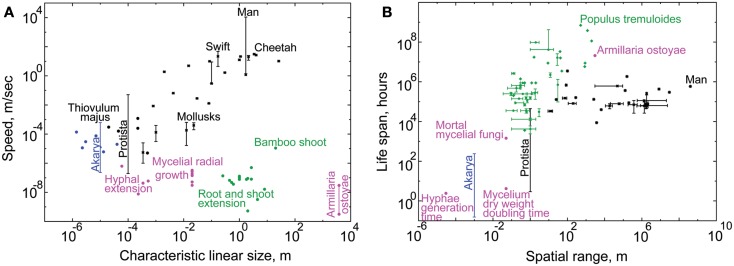Figure 2.
The tendencies for scope size evolution in the six kingdoms. In our theory, linear size and spatial range of individuals model spatial scope size. Life span models temporal scope size. By plotting these variables one against another, we demonstrate the differences in scope sizes among organismal kingdoms. Blue dots mark akarya, black dots – Protista, magenta dots – Fungi, green dots – Plants, and black stars – Metazoa. Vertical and horizontal lines indicate known ranges, not standard errors (see Datasheet S1 in Supplementary Material). Each datapoint displays measurements characteristic to individuals of a species, except for fungal data, which emphasize the spatio-temporal ranges of hyphae and mycelia (see text for explanation). It is notoriously difficult to measure the linear size and spatial range of individuals for some kingdoms, and their horizontal location on the graph should be taken with a grain of salt (see Text and Methods in Datasheet S4 in Supplementary Material). (A) This graph emphasizes the different strategies of spatial scope size evolution between Metazoa and Fungi/Plants. Sessile Plants and Fungi can grow to very large sizes (up to the largest known fungal genet of Armillaria ostoyae); while Metazoa achieve great motility speeds (man is the fastest). Thiovulum majus on top of the akaryal bar marks the fastest known bacterial species. (B) This graph demonstrates the different emphases in evolution of temporal and spatial scope size between Metazoa and Fungi/Plants. The kingdoms of Plants and Fungi evolve individuals with very long life spans (up to the longest-living known plant genet of Populus tremuloides), while Metazoa evolve individuals with very broad spatial ranges (man travels the farthest). Together parts (A,B) of this figure show the differences in tendencies for scope size evolution between Metazoa and Plants/Fungi: the former evolve wider spatial scope, while the latter evolve wider temporal scope, relative to one another. See Datasheet S4 in Supplementary Material for Methods.

